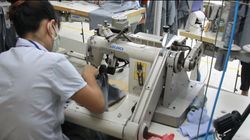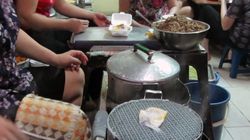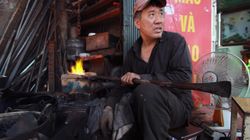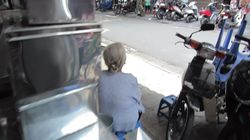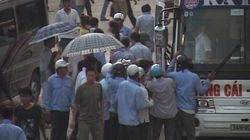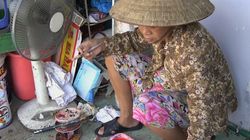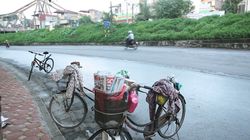Hanoi|Vietnam
Statistische Daten
Google-Einträge für Hanoi + Hà Nội 278,2 Mio.
Google-Einträge pro Einwohner (urban) 96,193
Stadtgründung 1010
http://de.wikipedia.org/wiki/Hanoi
BEVÖLKERUNG
Stadtgebiet 2.89 Mio. (2011) [1]
Provinz 6.8 Mio. [2]
Hanoi Capital Region 12.46 Mio. (2006) [3]
[1] http://www.gso.gov.vn/default.aspx?tabid=387&idmid=3&ItemID=12869
[2] Statistical Handbook of Vietnam 2012; http://www.gso.gov.vn/default_en.aspx?tabid=515&idmid=5&ItemID=13700
[3] http://en.wikipedia.org/wiki/Hanoi_Capital_Region
Fläche
2008, vor der Gebietsreform 920 km² [1]
nach der Gebietsreform 3.324 km² [2]
davon landwirtschaftlich genutzt ca. 2/3 [3]
Hanoi Capital Region 13,436 km² [4]
[1] http://academia.edu/1784635/Peasants_or_Peddlers_Mobile_Street_Vendors_in_Hanoi_Vietnam
[2] http://en.wikipedia.org/wiki/Hanoi
[3] http://www.vrm.ca/documents/Hanoi_Urbanization.pdf
[4] http://en.wikipedia.org/wiki/Hanoi_Capital_Region
Bevölkerungsdichte (Einwohner / km²)
Gesamtgebiet 1.875 [1]
städtische Gebiete 27.200 [2]
historischer Kern 40.400 [2]
[1] http://de.wikipedia.org/wiki/Hanoi
[2] http://www.utwente.nl/ctw/vvr/education/Master/finished_graduation_projects/afstudeerders_per_jaar_2/pdf/2013_Peter_Sanders.pdf
Anteile ländlicher und städtischer Bevölkerung (2009)
Gesamt 6,451,909
Ländlich 3,816,750
Städtisch 2,632,087
http://www.vietnamonline.com/az/hanoi-population.html
KLIMA
Max. Temperatur Ø 27,0
Min. Temperatur Ø 20,9
Niederschlag / Jahr (mm) 1.676,2
Regentage 144,5
http://en.wikipedia.org/wiki/Hanoi
Geschlechterverhältnis (Vietnam)
zu Geburt 1.12 Männer / Frauen
0-14 1.1 Männer / Frauen
15-24 1.07 Männer / Frauen
25-54 1 Mann / Frau
55-64 0.83 Männer / Frauen
65 und älter 0.62 Männer / Frauen
Gesamtbevölkerung 1 Mann / Frau (2013 geschätzt)
https://www.cia.gov/library/publications/the-world-factbook/geos/vm.html
Lebenserwartung (Vietnam)
Gesamtbevölkerung 72,6 Jahre
Männer 70,2 Jahre
Frauen 75,4 Jahre
https://www.cia.gov/library/publications/the-world-factbook/geos/vm.html
Urbanisierungsgrad (Vietnam)
2002 24,00%
2012 34,00%
zum Vergleich
Deutschland 74,00%
Welt 50,50%
http://www.asiantrendsmonitoring.com/2012/10/12/bulletin-18/
Wirtschaft
Wirtschaftswachstum (Vietnam)
1992 - 1997 durchschnittlich über 8%
2000 - 2007 durchschnittlich über 7%
2012 5%
http://www.imove-germany.de/cps/rde/xchg/imove_projekt_de/hs.xsl/vietnam.htm?news-type=&content-url=/cps/rde/xchg/imove_projekt_de/hs.xsl/17478.htm
Inflationsrate (Vietnam)
2008 23%
2011 18,6%
2012 9,7%
http://www.imove-germany.de/cps/rde/xchg/imove_projekt_de/hs.xsl/vietnam.htm?news-type=&content-url=/cps/rde/xchg/imove_projekt_de/hs.xsl/17478.htm
Verhältnis landwirtschaftlicher zur industriellen Produktion (Vietnam)
Anteil Landwirtschaft am Gesamt-BIP 2002 25%
Anteil Landwirtschaft am Gesamt-BIP 2010 20%
Anteil Industrie am Gesamt-BIP 2002 36%
Anteil Industrie am Gesamt-BIP 2010 40%
Das GDP Vietnams hat sich zwischen 2002 und 2010 verdreifacht.
http://libcom.org/library/class-struggle-vietnam-colonial-yoke-wage-slavery-global-capital
Die 10 größten vietnamesischen Unternehmen 2012
- Vietnam National Oil and Gas Group (PetroVietnam; staatlich)
- Vietnam National Petroleum Corporation (Petrolimex; staatlich)
- Vietnam Posts and Telecommunications Group (VNPT; staatlich)
- Samsung Electronics Vietnam Limited Company
- Vietnam-Russia Oil and Gas Joint Venture (Vietsovpetro; staatlich)
- durch das Militär geführte Telecom Group (Viettel; staatlich)
- Saigon Jewellery Limited Company (SJC)
- The Electricity of Vietnam Group (EVN)
- Vietnam National Coal-Mineral Industries Group (Vinacomin; staatlich)
- Vietnam Bank for Agriculture and Rural Development (Agribank; staatlich)
http://www.dtinews.vn/en/news/018/26573/state-owned-firms-dominate-list-of-vietnam-s-top-companies.html
Staatsbetriebe (Vietnam)
Gesamtverluste 2012 82.6 Mio. EUR
Gesamtschulden 11.7 Mrd. EUR
Gesamtumsätze 58.2 Mrd. EUR
http://www.saigon-gpdaily.com.vn/business/2013/1/103970/
Arbeitslosenrate 2012
Vietnam 2,74%
Hanoi 2,15%
http://en.vietnamplus.vn/Home/Vietnam-reports-nearly-1-million-unemployed-people/201212/30678.vnplus
Beschäftigte nach Sektoren (Hanoi)
Land-, Forstwirtschaft, Fischfang 24,4%
Industrie und Bauwirtschaft 28,3%
Dienstleistungen 47,3%
Staatsbetriebe 19,4%
Private Firmen 77,9%
Ausländische Firmen2,6%
http://www.gso.gov.vn/default_en.aspx?tabid=515&idmid=5&ItemID=13474
Textil- und Bekleidungsindustrie (Vietnam)
Beschäftigte in der Textil- und Bekleidungsindustrie über 2 Mio.
Beschäftigte in der Elektronikindustrie ca. 120.000
https://www.usaita.com/pdf_files/WRC-Report-Vietnam.pdf
Vietnam General Confederation of Labour
The Vietnam General Confederation of Labour (VGCL) is the only trade union organization officially recognised in Vietnam. [...] The status of the VGCL as a trade union that represents not only its members but the whole working class of the country is sealed by Article 10 of the 1992 Constitution. At the end of 2007, the VGCL reported a total membership of six million, which accounted for 13.3 per cent of the total labour force. [...] The union membership in the state-owned and civil service sectors was 90 per cent.
http://www.ilo.org/wcmsp5/groups/public/---ed_dialogue/---dialogue/documents/publication/wcms_194680.pdf
The denial of associational rights to Vietnamese workers is rendered worse by the fact that not only is the organizing of independent unions legally prohibited, but the official union structure is also de facto dominated at the factory level by employers themselves. This is because enterprise-level union officials are typically chosen by factory managers, not workers, and are, most commonly, actually the company’s human resource managers.
https://www.usaita.com/pdf_files/WRC-Report-Vietnam.pdf
Wilde Streiks (sogenannte „wild cat strikes“ in Vietnam)
2007 700 [1]
2008 762 [1]
2009 218 [1]
2010 424 [1]
2011 981 [2]
[1] http://libcom.org/library/class-struggle-vietnam-colonial-yoke-wage-slavery-global-capital
[2] https://www.usaita.com/pdf_files/WRC-Report-Vietnam.pdf
The role of enterprise unions, as promoted by the authorities, is to act as ‘the bridge of communication’ or a mediating body between employers and workers rather than the representative of workers’ interests in opposition to employers. Unsurprisingly, none of the strikes in the last 13 years was organised by the official unions.
http://www.esrc.ac.uk/my-esrc/grants/RES-155-25-0071/outputs/Download/c8114d8a-52aa-4acb-9316-deff89fc3028
“The key difference between Vietnam and China is that the All-China Federation of Trade Unions is being pushed by the Communist party to take on the work of representing workers and controlling the situation,” says Mr Yoon. Although they are not typically supporters of enhanced labour rights, some factory managers in Vietnam also want to see stronger worker representation to ensure better lines of communication.
“Our workers went on strike after their rice portions were cut by the catering contractor who was trying to save money because of inflation,” says one European factory manager. But because the official trade union was not acting as an effective communication channel, the company had no way of knowing about the problem until it was too late, he says.
http://www.ft.com/intl/cms/s/0/67380b5c-427e-11e1-97b1-00144feab49a.html#axzz2dBbR6mWv
Arbeitssicherheit (Ergebnisse von Fabrikbesichtigungen innerhalb des ILO-Better-Work-Vietnam-Programms)
27% der besichtigten Fabriken hatten verschlossene oder nicht zugängliche Notausgänge. In 32% der besichtigten Fabriken hatten die Arbeiter keine notwendige Schutzkleidung. In 23% der besichtigten Fabriken waren die Arbeiter gesundheitsgefährdenden Chemikalien ausgesetzt.
https://www.usaita.com/pdf_files/WRC-Report-Vietnam.pdf
Of factories audited for the FLA (Fair Labor Association) between 2009 and 2011, 80% violated basic requirements related to emergency evacuation, with common violations including blocked aisles and locked exits, lack of fire alarms and smoke detectors, and failure to conduct fire drills or test electrical systems. Seventy percent of factories audited for the FLA during this period also failed to provide workers with required personal protective equipment, and 52 % had not installed necessary guards on machinery.
https://www.usaita.com/pdf_files/WRC-Report-Vietnam.pdf
INFORMELLER SEKTOR
Definition informeller Sektor
A firm is classified as informal if it belongs to households and is not registered under factories or commercial acts, tax or social security laws, professional groups’ regulatory acts or similar acts, laws or regulations established by national legislative bodies” in the statistical or tax institution or if it does not keep written accounts.
http://wiego.org/sites/wiego.org/files/publications/files/Herrera_WIEGO_WP9.pdf
Informelle Arbeit in Hanoi nach Anzahl der Beschäftigten (2007)
formeller landwirtschaftlicher Sektor 3.495 Beschäftigte
informeller landwirtschaftlicher Sektor 205.582 Beschäftigte
formeller nicht-landwirtschaftlicher Sektor 738.303 Beschäftigte
informeller nicht-landwirtschaftlicher Sektor 635.016 Beschäftigte
http://wiego.org/sites/wiego.org/files/publications/files/Herrera_WIEGO_WP9.pdf
Informelle Arbeit in Hanoi nach Aktivität in Prozent (2007)
Landwirtschaft 24,46%
Handel 26,22%
davon Straßenhandel 11,33%
Dienstleistungen 26,86%
Bau 6,79%
Fertigung 15,67%
Heimarbeit 33,54%
http://wiego.org/sites/wiego.org/files/publications/files/Herrera_WIEGO_WP9.pdf
Informelle Arbeit in Hanoi nach Prozent der Beschäftigten (2007)
informeller Sektor 53,12%
formeller Sektor 46,88%
http://wiego.org/sites/wiego.org/files/publications/files/Herrera_WIEGO_WP9.pdf
Straßenhändler (2007)
6% aller Beschäftigen
11% aller Beschäftigten im informellen Sektor
http://wiego.org/informal-economy/occupational-groups/street-vendors
VERKEHR
Motorräder
80% aller Haushalte besitzen 1 Motorrad
40% aller Haushalte besitzen 2 Motorräder
auf 1.000 Einwohner kommen 600 Motorräder
http://www.codatu.org/wp-content/uploads/ALLAIRE-CODATU_Hanoi-EN.pdf
Wachstumsraten der Zulassungen
Autos 21%
Motorräder 13%
http://www.codatu.org/wp-content/uploads/ALLAIRE-CODATU_Hanoi-EN.pdf
Verhältnis Straßennetz zu Landfläche
Hanoi 7%
größere chinenische Städte 11%
europäische Städte 15%
http://www.vrm.ca/documents/Hanoi_Urbanization.pdf
Modal share (in %)
Motorrad 1995 37 2008 81
Auto 1995 1 2008 4
Fahrrad 1995 47 2008 2
Bus 1995 2,5 2008 11 (2012 15%) [2]
Andere 1995 12,5 2008 2
http://www.codatu.org/wp-content/uploads/ALLAIRE-CODATU_Hanoi-EN.pdf
[2] http://en.hanoi.vietnamplus.vn/Home/Hanois-bus-drivers-told-to-ease-up/20128/2501.vnplus
Öffentlicher Verkehr
Buslinien 58
Haltestellen 1.200
Passagiere / tgl. 1,3 Mio
http://en.hanoi.vietnamplus.vn/Home/Hanois-bus-drivers-told-to-ease-up/20128/2501.vnplus
Busfahrgastzahlenentwicklung
2000 31 Linien mit ca. 11 Mio. Passagieren
2005 47 Linien mit ca. 300 Mio. Passagieren
2010 65 Linien mit ca. 450 Mio Passagieren
http://www.codatu.org/wp-content/uploads/ALLAIRE-CODATU_Hanoi-EN.pdf
Metro (geplant)
5 Linien bis 2030
Fertigstellung der 1. Linie vorraussichtlich 2015
http://www.afd.fr/lang/en/home/pays/asie/geo-asie/afd-vietnam/projets-vn/transports/projet-de-ligne-pilote-de-transport-ferre-urbain-nhon-gare-de-hanoi-1
Löhne
Durchschnittseinkommenfür Lohnarbeiter/innen (3. Quartal 2012)
Hanoi; urban
Männer 5.805.900 VND (209,52 EUR)
Frauen 5.281.200 VND (190,55 EUR)
Vietnam
Männer 3.924.200 VND (141,57 EUR)
Frauen 3.532.000 (127,48 EUR)
http://www.gso.gov.vn/default_en.aspx?tabid=515&idmid=5&ItemID=13669
A 2012 study by the VGCL’s Institute of Workers and Trade Unions found that wages for workers in the footwear industry averaged only $ 124 per month, less than the average monthly wage figure for workers in all formal sector industries ($ 136), and the lowest wage of any sector surveyed. According to the VGCL survey, the average wage for a footwear worker provided barely half of the amount the average family of three needed to cover food expenses alone ($ 220 per month).
https://www.usaita.com/pdf_files/WRC-Report-Vietnam.pdf
Mindestlohn / Monat (2013)
Zone 1, Hanoi städtisch VND 2.35 Mio. (84,77 EUR)
Zone 2, Hanoi ländlich VND 2.1 Mio. (75,74 EUR)
http://talkvietnam.com/2012/12/vietnams-wage-growth-higher-than-average-ilo/#.UeUFB23pzTo
Denying workers the wages and benefits they are legally due is a pervasive violation in Vietnam’s export apparel sector. Factory inspections by the ILO’s Better Work Vietnam program found that 19% of factories failed to pay the legal minimum wage for workers’ regular hours, and that 30% did not provide workers with the mini mum legal compensation for overtime hours.
https://www.usaita.com/pdf_files/WRC-Report-Vietnam.pdf
Offizielle Armutsgrenze (2012)
in ländlichen Gebieten VND 400,000 = 14,42 EUR / Monat [1]
in städtischen Gebieten VND 653,000 = 23,25 EUR / Monat [2]
Haushalte in Hanoi unterhalb der Armutsgrenze 59,360 [3]
davon in ländlichen Gebieten 51.900 [3]
[1] http://english.vov.vn/Society/Development/Vietnams-poverty-line-getting-close-to-global-level/261291.vov
[2] http://www.asiantrendsmonitoring.com/2012/10/12/bulletin-18/
[3] http://english.vov.vn/Society/Development/Hanoi-aims-to-lower-poverty-rate/253885.vov
It takes a minimum of VND 1,000,000” (approximately US$ 50) for a person to survive for a month in Hanoi, while the current urban poverty line is set at VND 653,000 (US$ 32.65)
http://www.asiantrendsmonitoring.com/2012/10/12/bulletin-18/
Lebenshaltungskosten
Preise (in EUR)
12 Eier 1,68,-
1 kg Tomaten 0,52,-
Brot für 2 Personen (1 Tag) 0,53,-
0,5 Liter Bier im Supermarkt 0,59,-
1 Liter Vollmilch 1,05,-
Stundenlohn Putzhilfe 3,85,-
Monatsmiete für ein 85 qm-Wohnung
in einem teuren Stadtviertel 525,-
1 Liter Benzin 0,72,-
Monatskarte ÖPNV 5,41,-
Taxifahrt (8 Km) 4,01,-
http://www.expatistan.com
INTERNET
Internetnutzer (Vietnam, 2012)
2000 2 Mio.
2012 31 Mio.
Alter 15-22 (Hanoi) bis zu 95%
80% der jungen Vietnamesen haben mindesten einen Social-Network-Account.
Facebook-Nutzer mehr als 10 Mio.
http://www.fidh.org/IMG//pdf/bloggers_report_in_english.pdf
Gefängnisstrafen gegen vietnamesische Blogger wegen
„Verbreitung staatsfeindlicher Propaganda“ am z.B. 24.09. 2012
Nguyễn Văn Hải 12 Jahre (anschließend 5 Jahre Hausarrest)
Ms. Tạ Phong Tần 10 Jahre (anschließend 3 Jahre Hausarrest)
Phan Thanh Hải 4 Jahre
http://www.fidh.org/IMG//pdf/bloggers_report_in_english.pdf
Over 850 newspapers and magazines, 68 radio stations, thousands of news websites and 80 e-newspapers
in Vietnam are all run by Party-controlled, military or government agencies.
http://www.fidh.org/IMG//pdf/bloggers_report_in_english.pdf


